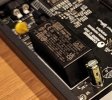
Did you read my
reply where I thoroughly listed the RME ADI-2 DAC FS features that Element IV lacks? And all you have to say is it has three more EQ bands? The only limiting factor about the RME's EQ to me is not the number of bands but the steps and ranges of adjustment. Still it's mostly adequate, and I can satisfactorily equalize any of my headphones/IEMs to desired targets.
0.2 dB higher output (+22.2 dBu vs +22 dBu, so less than 1% of a difference) is "substantially more", yes. And then there is the balanced headphone output of the Pro versions, with its nearly 20 V RMS (+28 dBu) output. But why would you need such high output levels to begin with?
Import where specifically? It's been established already that the web app can apply only one EQ setting to the XMOS chip; you can't switch between presets on the fly. It doesn't even have separate settings for left and right channels. OTOH, the RME has memory for 20 EQ presets that are stored on the device and available instantly. Additionally, one can use the desktop remote app to load EQ presets from files and to export them to files.


